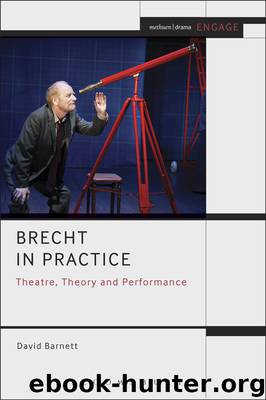Brecht in Practice by Barnett David

Author:Barnett, David
Language: eng
Format: epub
Publisher: Bloomsbury UK
Playing the situation and not the character, or: The problem of saying ‘I’
Brecht understands the individual not as a lone, autonomous entity, but as a person in constant dialogue with his or her social surroundings. This dialectical understanding of the individual undermines one of the central ideas of Stanislavsky’s actor training. Stanislavsky divides dramatic scenes into smaller, manageable units, much as Brecht divides them up into the step-by-step unfolding of a scene’s Fabel (see Chapter 4). Yet at the heart of Stanislavsky’s units are the characters’ objectives, goals that are to be achieved through action. Bella Merlin, an expert on using the practitioner’s theories in practice today, states: ‘the best way to express an objective [ . . . ] is to start by saying “I want to . . . [do something]” ’.23 ‘I want’ suggests a degree of control over events. The problem with this position for a Brechtian actor is that the ‘I’ is not in some way detached, but enmeshed in a variety of social forces: the figures in Brecht’s and other dramatists’ plays often act under the pressure of events they are often unable to control.
Here are a couple of examples:
• In the third scene of Mother Courage, Courage’s son, Swiss Cheese, has been captured by the enemy army. Courage tries to sell her wagon, her only means of generating income, to raise money that will be used to bribe the soldiers and save her son’s life. However, she spends too much time haggling over the price, and Swiss Cheese is shot by firing squad.
• What does Courage want here? She wants both to save her son and to get the highest price for her wagon. The two desires are, in this case, mutually exclusive, because the time taken to agree the price for the wagon is that time it takes for the firing squad to execute the prisoner. If Courage’s desire is ‘I want to save my son’, then she would have accepted the lower price offered, but her behaviour has already been conditioned by the laws of the market: a sale is only worth making when it brings the maximum yield. It is thus not Courage who is acting in the bargaining process, but the logic of doing business that she has absorbed over time. A Brechtian theatre can deploy the ‘not – but’ (see Chapter 3) to show that Courage is not acting in her own interests, but in those of the market here.
• Arthur Miller’s The Crucible, a play about the Salem witch-hunt trials of the late seventeenth century, shows how hysteria can be manufactured and exploited to achieve certain ends: members of the community denounce each other as witches in order to settle old scores or gain material advantage over each other. The action reaches a climax at the end of the third act. The play’s hero, John Proctor, tries to put an end to the persecution of his wife as a witch by exposing Abigail, the ringleader of the group of girls accusing other citizens of witchcraft.
Download
This site does not store any files on its server. We only index and link to content provided by other sites. Please contact the content providers to delete copyright contents if any and email us, we'll remove relevant links or contents immediately.
| Books & Reading | Comparative Literature |
| Criticism & Theory | Genres & Styles |
| Movements & Periods | Reference |
| Regional & Cultural | Women Authors |
4 3 2 1: A Novel by Paul Auster(11071)
The handmaid's tale by Margaret Atwood(6867)
Giovanni's Room by James Baldwin(5889)
Big Magic: Creative Living Beyond Fear by Elizabeth Gilbert(4730)
Asking the Right Questions: A Guide to Critical Thinking by M. Neil Browne & Stuart M. Keeley(4591)
On Writing A Memoir of the Craft by Stephen King(4220)
Ego Is the Enemy by Ryan Holiday(3999)
Ken Follett - World without end by Ken Follett(3980)
The Body: A Guide for Occupants by Bill Bryson(3813)
Bluets by Maggie Nelson(3721)
Adulting by Kelly Williams Brown(3678)
Guilty Pleasures by Laurell K Hamilton(3597)
Eat That Frog! by Brian Tracy(3522)
White Noise - A Novel by Don DeLillo(3439)
The Poetry of Pablo Neruda by Pablo Neruda(3370)
Alive: The Story of the Andes Survivors by Piers Paul Read(3317)
The Bookshop by Penelope Fitzgerald(3234)
The Book of Joy by Dalai Lama(3231)
Fingerprints of the Gods by Graham Hancock(3218)
